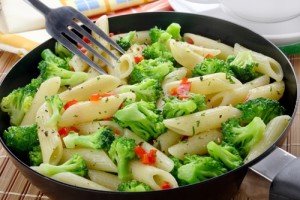4 Tips For Cooking Better Pasta

Pasta’s simplicity is part of what makes it such an indispensable culinary staple. Once you have chosen the right size and shape of noodles for your dish, you can focus on the fillings and sauces that are usually the star of the meal. But maybe you should reconsider just following the directions on the box. With a few tips, you can learn to cook pasta that is more flavorful, satisfying and even healthier.
1. Use a large pot and cold water
For the best texture, you should boil your noodles in a big pot, about filled three-quarters with cold water. Chef Sara Jenkins told Bon Appetit that a ratio of at least 6 quarts of water per pound prevents the pasta from becoming sticky and mushy as it expands.
The New York Times stated that the belief that cold water will boil faster than hot is a myth. However, it may still be wise to use cold water because warm tap water can contain more dissolved impurities.
2. Add salt
You pasta will benefit from pouring salt into the water as it is reaching a boil. While the sodium will not have a significant effect on the boiling point, it will make the final product tastier. Some chefs, like Jenkins, advise going quite heavy on the salt. However, Serious Eats suggested that a moderate amount would do the job. Depending on personal taste, aim for a ratio between 3/4 of a teaspoon and 1 tablespoon of salt per quart of water.
On the other hand, you definitely should not add oil to the pot. The Smithsonian discussed the idea that olive oil stops the water from boiling over and keeps pasta from sticking. In fact, stirring should be enough to prevent stickiness, and pouring your freshly cooked noodles through a layer of olive oil makes it more difficult for sauce to cling to them.
 3. Don’t overcook
3. Don’t overcook
Aim to boil your pasta to until it is al dente, which is to say cooked but still satisfyingly chewy. In addition to being more enjoyable, al dente pasta may also be better for you. As The Glycemic Index Foundation explained, cooking the pasta less means it takes longer to digest, which moderates the resulting fluctuations in your blood sugar.
Once the pot returns to a boil after you add the noodles, remove the lid or at least prop it open. This will avoid boiling over and give you easier access to check on the cooking progress. Taste the pasta regularly while it cooks, testing for flavor and texture every 20 seconds or so as it approaches completion.
Jason Pfeifer of New York City restaurant Maialino told Epicurious that it is important to remove the pot from heat while the pasta is still a little firmer than al dente. Since you should complete the cooking process by simmering the noodles in sauce for a minute, taking them off the burner early will stave off overcooking.
4. Hold on to the pasta water
Don’t immediately pour all the starchy water you used to boil the noodles down the drain. This liquid makes an excellent thickener for sauces, adding body and making for a smoother coating. The Kitchn instructed taking out half a cup of the pasta water before draining. When you do drain, never rinse the noodles off; that will wash the starch away.
If you prefer, you can also add more starch to the mix during the cooking process. According the Tasting Table, San Francisco-based chef Thomas McNaughton advised adding semolina flour when the water is boiling. This will simulate the effects of using the same pot all day to make pasta, as occurs in a professional kitchen.






Recent Comments